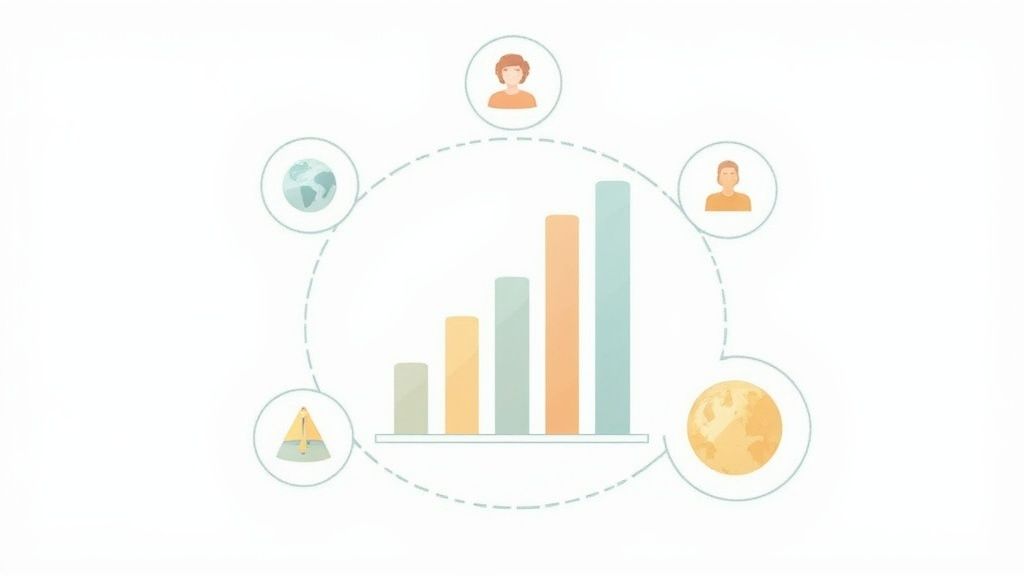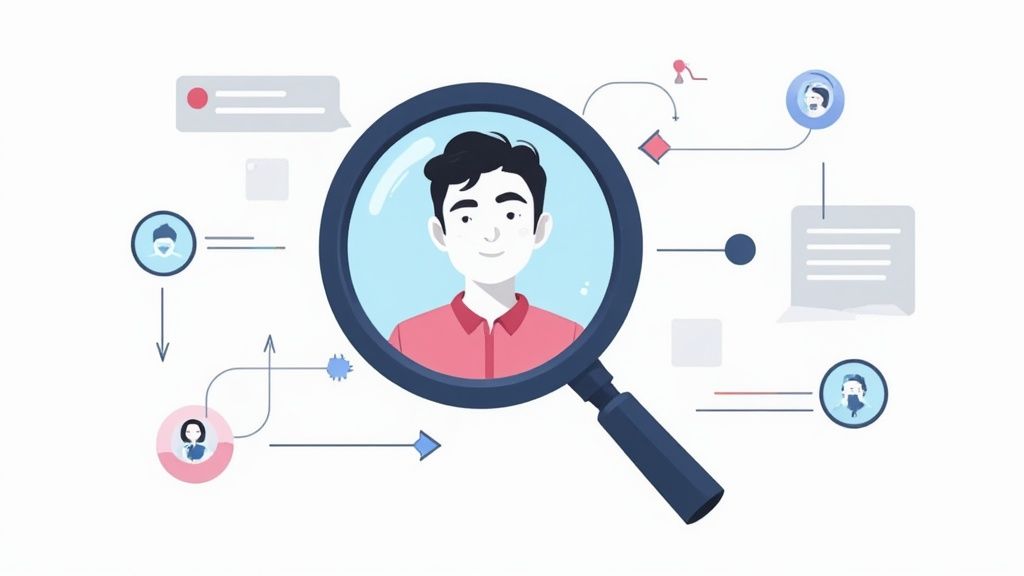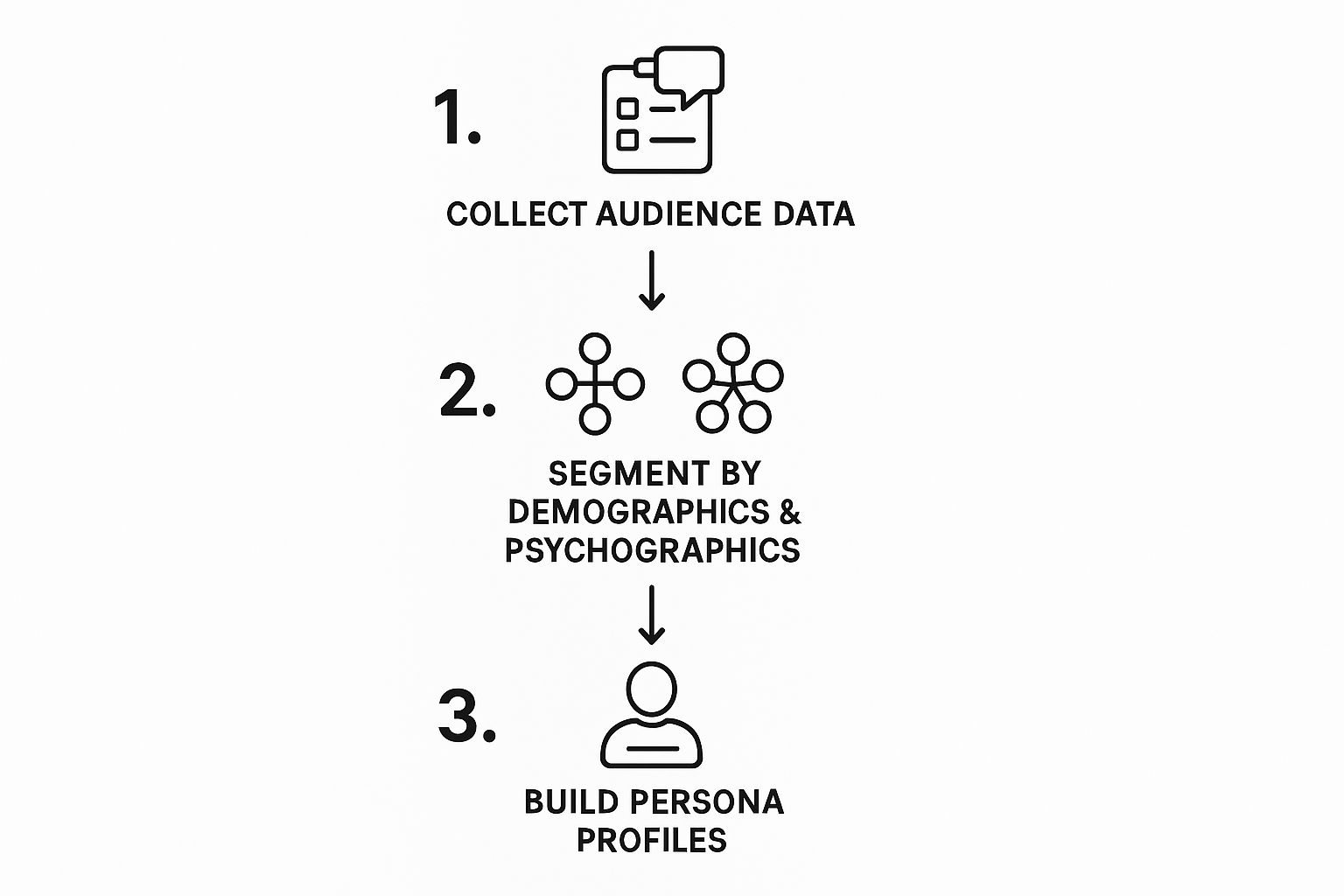Mastering Target Audience Analysis for Growth

Target audience analysis is really just the process of figuring out who your best customers are—or who they could be. It involves digging into their demographics, interests, and behaviors to craft marketing that actually speaks their language. Think of it as the difference between shouting into a crowded room and having a real conversation with someone who's genuinely interested in what you have to say.
Why Target Audience Analysis Is Your Marketing North Star
Before you even think about spending a single dollar on ads, you have to know who you’re talking to. A deep, honest target audience analysis isn't just a nice-to-have; it's the absolute foundation of any marketing strategy that has a chance of succeeding. Skip this step, and you’re basically just guessing—and that leads to wasted ad spend, generic messages, and products that just don't hit the mark.
Imagine a high-end vegan skincare brand spending its entire budget on TV ads during a primetime show. The problem? The show’s main audience is older men who just want budget-friendly basics. The campaign is doomed from the start. It’s not because the product is bad, but because they're talking to a completely different crowd. This is exactly what happens when you don't do your homework first.
Avoid Wasted Resources and Sharpen Your Focus
When you have a crystal-clear picture of your audience, you stop making those kinds of expensive mistakes. It allows you to pour your resources—time, money, and creative energy—into the channels and messages that will actually make a dent. That kind of precision is everything in today's crowded market.
With the internet now used by 5.56 billion people worldwide, which is 67.9% of the global population, just "being online" isn't a strategy. You have to carve out your specific corner of that massive digital space.
To get started, it's helpful to break down what you actually need to find. A solid analysis rests on a few core pillars of information.
Core Components of a Target Audience Analysis
Here's a quick look at the essential data points you should be gathering.
| Component | What It Tells You | Example Data Points |
|---|---|---|
| Demographics | The "who" of your audience. | Age, gender, location, income level, education, family status. |
| Psychographics | The "why" behind their actions. | Values, beliefs, interests, lifestyle, personality traits, hobbies. |
| Behavioral Data | The "how" they interact with brands. | Buying habits, online activity, social media usage, brand loyalty. |
| Pain Points | The problems they need to solve. | Challenges, frustrations, unmet needs, obstacles. |
Collecting this information is what gives you a complete, three-dimensional view of the people you want to reach.
The real goal of target audience analysis is to stop making broad assumptions and start using specific, data-backed insights. It’s what turns your marketing from a shotgun blast into a laser beam, lighting up the path straight to customers who are already looking for you.
Ultimately, knowing your audience is where every successful campaign begins. This foundational work informs every single thing you do next, from the features you build to the content you write, creating the kind of genuine brand loyalty that actually lasts.
Building Your Audience Profile Beyond Demographics

Knowing your audience’s age and where they live is a decent starting point, but let’s be honest—it’s just scratching the surface. Real, lasting connections are built when you understand why people do what they do. This is where we move past the simple "who" and start digging into the "why" that truly drives your customers.
The best audience analysis always layers two kinds of data: demographics and psychographics. Think of demographics as the factual skeleton (age, income, location). Psychographics, on the other hand, add the personality, motivations, and human element that make your audience profile feel real.
First, Nail Down the Foundational Demographics
Let's get the basics locked in. This data is usually the easiest to pull from your analytics tools and gives you the essential structure for your audience segments. It answers the most fundamental questions about who you're talking to.
Key demographic data points to look for include:
- Age: Are you marketing to Gen Z, millennials, or baby boomers? Their communication styles, values, and preferred platforms are worlds apart.
- Location: An urban professional has vastly different needs and daily experiences than someone in a rural community. Regional targeting can make your ads feel much more relevant.
- Income Level: This has a direct line to purchasing power and price sensitivity. It helps you position your product without alienating your core customer.
- Education and Occupation: These factors often clue you into their interests, the professional jargon they use, and the specific challenges they face in their careers.
Here’s a classic mistake I see all the time: stopping right here. Demographics tell you who buys your product, but psychographics reveal the crucial context of why they chose you over a competitor. This deeper knowledge is what separates generic, forgettable marketing from messaging that truly hits home.
Now, Dive into Meaningful Psychographics
Psychographics are all about the attitudes, values, and beliefs that drive behavior. This is where you uncover the real-life frustrations and aspirations your brand can actually solve. It's about seeing the world through their eyes.
To get this information, you have to go beyond analytics dashboards and just listen. Customer interviews, surveys, and even just lurking in relevant social media conversations are absolute goldmines for this kind of data.
You want to ask questions that get to their core motivations:
- What are their biggest daily frustrations, either at work or in their personal life?
- What do they value most in a product like yours? (Is it convenience, sustainability, luxury, or something else?)
- What are their long-term goals and dreams?
- What kind of content do they consume? (Think blogs, podcasts, newsletters, and specific influencers.)
For example, a company selling project management software might know its demographic is "project managers, aged 30-45." But a dive into psychographics could reveal their core pain point is "feeling completely overwhelmed by chaotic team communication and constant missed deadlines." Their biggest goal? "Finally achieving a decent work-life balance."
That insight is infinitely more powerful. You’re no longer just selling software; you’re selling them peace of mind and a clear path to efficiency. For more on this, it's worth exploring the idea of understanding your audience beyond basic demographics.
When you combine these two data types, you transform a flat, one-dimensional data point into a rich, three-dimensional customer profile. You stop seeing "females, 25-34" and start seeing "Sarah, a marketing manager who values sustainability, struggles with content creation, and dreams of starting her own side hustle."
Now that is a person you can have a real conversation with.
Finding Your Audience in Their Digital Habitats

Alright, you've sketched out a profile of your ideal customer. Now for the real detective work: where do these people actually hang out online? A top-notch audience analysis goes beyond who your audience is; it’s about knowing where they are so you can show up and meet them on their own turf.
Think about it. Your ideal customers are already out there—sharing opinions, asking for advice, and looking for solutions. The goal is to pinpoint these digital stomping grounds, listen in on the chatter, and get a feel for the unique culture of each space. This isn't about finding new places to drop ads; it's about discovering genuine opportunities to connect.
Pinpoint Their Favorite Platforms
Every social media platform has its own vibe and its own crowd. A marketing strategy that absolutely crushes it on LinkedIn will almost certainly get crickets on TikTok. That's why you have to figure out the primary channels your audience truly prefers.
The user demographics of these platforms tell a big part of the story. For instance, Instagram's user base skews young, with the 18-24 age group making up a massive 31.7% of its audience. This makes it a goldmine for brands targeting that demographic. Likewise, with one in four users under 20, TikTok has become a non-negotiable channel for businesses trying to connect with Gen Z.
So, how do you find these hotspots?
- Social Listening: Fire up tools that track mentions of keywords tied to your industry or brand. You'll see not just what people are saying, but where they're saying it.
- Competitor Analysis: See where your competitors are putting their energy. Check their follower counts, engagement rates, and the kind of content they’re sharing on each platform to see what’s resonating.
- Customer Surveys: Just ask! A quick survey of your existing customers can reveal which platforms they use most often, both for work and for fun.
Remember, presence doesn’t equal preference. Your audience might have an account on every major platform, but they likely have one or two favorites where they are most active and receptive. Your job is to find those core channels.
Analyze Online Communities and Forums
Look beyond the big social networks. Niche communities are where you’ll find unfiltered, honest conversations. Forums like Reddit and private Facebook Groups are treasure troves of candid opinions, in-depth discussions, and emerging trends.
Imagine you sell ergonomic office chairs. You could strike gold in subreddits like r/WorkFromHome or r/OfficeChairs. In these communities, people are openly complaining about their back pain, asking for specific recommendations, and posting incredibly detailed reviews of products they’ve tried.
When you're exploring these groups, keep an eye on a few things:
- The Language and Slang: Picking up on your audience's vocabulary helps your brand sound like an insider, not a corporate robot.
- Recurring Questions: What problems pop up again and again? These are neon signs pointing toward your next blog post or product feature.
- Product Mentions: Take note of which products—including your competitors'—get praise or criticism, and more importantly, why.
Understand the Context of Each Channel
Finally, context is everything. Someone scrolling LinkedIn on their lunch break is in a completely different headspace than when they’re killing time on Instagram. Every platform has its own unwritten rules of engagement.
A deep, thought-provoking post can be a massive hit on LinkedIn, which is why a dedicated LinkedIn content strategy is so critical for B2B success.
But that same post would be a total flop on Instagram, where eye-catching visuals, quick videos, and relatable captions are king. A truly useful audience analysis doesn’t just give you a list of platforms; it tells you how to act when you get there so you can build real connections.
Using Analytics Tools for Deeper Audience Insights

Gut feelings are a great starting point, but data is what really drives growth. While talking to your audience gives you the rich, qualitative "why," analytics tools deliver the hard, quantitative evidence you need to back up your hunches and spot patterns you'd otherwise miss.
This is where your audience research shifts from educated guesses to a data-backed strategy. But don't get lost in a sea of charts and metrics. The real trick is to approach your analytics with specific questions you want to answer. You're not just looking at numbers; you're looking for the stories they tell about the people behind the screens.
Tapping into Your Website Analytics
Think of your website as a 24/7 focus group. Tools like Google Analytics are your one-way mirror, letting you observe exactly who's showing up and what they're doing. It’s one of the most powerful, and often free, resources you have.
To get a clearer picture of your site's performance and who's visiting, you can explore a detailed guide to a website analytics dashboard.
But to get started, focus on these key reports:
- Audience Reports: This is your first stop for a demographic snapshot. You can see the age, gender, and geographic location of your visitors. Are you hitting your target, or is there a surprising new audience segment you should be paying attention to?
- Acquisition Reports: This tells you how people are finding you. Is most of your traffic coming from organic search, a specific social media channel, or referrals from another site? Knowing this shows you which channels are your heavy hitters.
- Behavior Reports: Dig into which pages are the most popular and, just as importantly, how long people stick around. High bounce rates on critical pages could mean your message isn't connecting or the user experience is falling flat.
Expert Tip: A common mistake is getting fixated on total traffic numbers. A much more telling metric is user engagement on your most important pages. Tons of traffic with very low engagement often means you're attracting the wrong crowd or your content simply isn't resonating.
Decoding Social Media and SEO Insights
Your website is just one piece of the puzzle. Social media platforms and SEO tools offer another crucial layer of information about your audience's broader world.
Each social media platform, from Meta's Business Suite to LinkedIn Analytics, provides a goldmine of demographic and engagement data. You can quickly see which posts get people talking and which ones are duds. If, for instance, your video content consistently gets 3x the engagement of your static images, that’s a massive clue about what your audience wants to see from you.
On the SEO side, tools like Semrush or Ahrefs let you peek at what your competitors are doing right and analyze what people are actually searching for. Seeing high search volume for a query like “how to fix [the exact problem your product solves]” is a direct line into your audience’s immediate needs.
To make sense of all this data, it helps to know which tool to use for which job.
Essential Tools for Audience Analysis
| Tool Category | Example Tools | Key Insights for Audience Analysis |
|---|---|---|
| Website Analytics | Google Analytics, Matomo | Uncover user demographics (age, gender, location), see how users find your site (acquisition channels), and track on-site behavior (popular pages, time on page). |
| Social Media Analytics | Meta Business Suite, LinkedIn Analytics, Sprout Social | Analyze follower demographics, identify top-performing content formats, and measure engagement rates to see what resonates. |
| SEO & Keyword Research | Semrush, Ahrefs, Google Search Console | Discover the search terms people use to find solutions you offer, analyze competitor strategies, and identify audience pain points based on search intent. |
| CRM Data | HubSpot, Salesforce | Pull data on existing customer demographics, purchase history, and common support questions to understand your most loyal audience segments. |
By piecing together these different data sources, you move beyond a single-channel view. You start to build a holistic picture of your target audience—what they do on your site, what they talk about on social media, and what they're actively searching for online. This is how you create marketing that truly connects.
Turning Your Research into Actionable Customer Personas
Alright, you've done the heavy lifting.You've waded through spreadsheets, analytics, and interview notes. All that raw data—the demographics, psychographics, and behaviors—is gold, but it's not useful until you shape it into something tangible. This is where we build our customer personas.
A great persona isn't just a placeholder or a generic template you downloaded. It's a semi-fictional character that feels like a real person. This is how you give your entire team a shared, crystal-clear picture of who they’re really working for. This step is about moving from abstract data to a practical tool that guides everything you do, from product tweaks to marketing campaigns.
Think of it as creating an avatar for your ideal customer—one who can have a seat at the table in every meeting.
Weaving a Human Story from Data
First, spread your research out and start looking for patterns. Are you seeing the same pain points pop up over and over again for a specific demographic? Do certain behaviors on your website line up with specific interests you found on social media? These clusters are the building blocks of your personas.
For each major segment you find, start fleshing out a profile. Don't just stick to the basics; give them some life.
- Name and Photo: This sounds simple, but it’s crucial. Give your persona a name (like "Marketing Manager Molly") and find a stock photo that fits. It immediately makes them more real and relatable than "Segment B, Persona 1."
- Role and Responsibilities: What's their day-to-day work life like? What are their main duties, and who do they have to answer to?
- Goals: What are they ultimately trying to accomplish? This can be professional, like "get a promotion," or personal, like "find a better work-life balance."
- Challenges and Pain Points: This is the most important part. What’s getting in their way? What are the biggest frustrations they face? This is exactly where your product or service needs to fit in as the solution.
The infographic below shows how all this comes together, moving from raw data to a finished, usable persona.

As you can see, the process isn't random. It’s a logical flow from broad information to a specific, actionable profile that can act as your team’s North Star.
Putting Your Personas to Work
A well-built persona gets everyone on the same page. Your marketing team will know what language to use in their ads. Your sales team will understand a prospect's core motivations. And your product team will have a clear user in mind when they're designing new features.
A persona isn’t just a document; it’s a decision-making tool. Before you launch anything new, ask yourselves: "What would Molly think of this? Does this actually solve her biggest problem?" This simple question keeps your entire strategy grounded in what the customer needs.
For instance, a B2B software company might develop a persona for "Startup Steve." He’s a founder who knows his way around tech but has zero time to spare. His main goal is rapid growth, but his biggest pain point is dealing with clunky, inefficient workflows.
With Steve in mind, every piece of content—from blog posts to email onboarding sequences—should be laser-focused on helping him save time and scale his company. These focused efforts are also a powerful way to build brand equity. If you want to dive deeper, we cover more on this in our guide to brand awareness strategies.
Ultimately, turning your analysis into rich, detailed personas ensures everyone in the company is speaking the same language—the customer's language. That alignment is what creates marketing that truly connects and gets results.
Turning Audience Insights into Marketing Wins
All that research and persona-building has been leading to this moment. An audience analysis is just an interesting report until you use it to make smarter decisions. This is where you connect the dots between what your audience actually cares about and your marketing strategy, turning all those learnings into real, tangible results.
Think of your carefully crafted customer persona as the new filter for every marketing move you make. It guides your messaging, helps you pick the right channels, and empowers you to create content that doesn't just get seen—it gets felt. Your analysis is what stops you from shouting into the void and starts genuine conversations with people who are already inclined to listen.
Refining Your Message with Audience Pain Points
Let's walk through a real-world example. Imagine a fintech company has developed a persona for "Freelancer Chloe." Through their analysis, they discover her biggest professional headache isn't finding clients—it's the constant, nagging anxiety of managing unpredictable cash flow and getting ready for quarterly tax payments.
Suddenly, their entire marketing approach can shift.
- Old, Generic Ad Copy: "The Best Invoicing Software for Small Business."
- New, Persona-Driven Ad Copy: "End Cash Flow Anxiety. Get Paid Faster and Automate Your Tax Savings with [Product Name]."
See the difference? The second version speaks directly to Chloe's fear and offers a clear, immediate solution. It's no longer about a list of features; it’s about solving a problem that genuinely affects her life. This is what drives higher ad click-through rates and better landing page conversions—the message connects on an emotional level.
The real win in a target audience analysis isn't just knowing who your customer is, but understanding what keeps them up at night. When your marketing speaks directly to that, you're not just selling a product; you're offering relief.
Choosing the Right Channels and Tailoring Content
Your analysis doesn't just tell you what to say; it tells you where to say it. If your data shows your ideal customers are all over LinkedIn, then investing your time and budget there is a no-brainer. This data-driven approach means you stop wasting money on platforms your audience completely ignores.
If you're looking for more ideas on this, check out our guide on how to get more engagement on LinkedIn.
This same principle applies on a global scale. Just look at YouTube. It's a massive platform, projected to hit 2.85 billion users by 2025, with India alone making up 491 million users. The most successful creators on the platform don't try to appeal to everyone. They succeed by tailoring their videos to very specific regional tastes, languages, and cultural interests, turning a massive, broad viewership into tight-knit, dedicated communities.
By using your target audience analysis to guide everything from your ad copy to your channel selection, you transform your research from a static report into a dynamic, results-driven marketing machine. You start making smarter bets, building stronger connections, and ultimately, delivering a much better return on your investment.
Even after you've nailed down the process, a few questions always seem to bubble up during an audience analysis. It’s a complex but absolutely critical task, so let's clear up some of the most common hangups I see people run into.
How Often Should I Refresh My Audience Analysis?
Think of your audience analysis as a living, breathing part of your strategy—not a one-and-done report you file away. For a full, deep-dive analysis, I recommend doing one annually or anytime you're gearing up for a major new product launch or campaign. This keeps your core understanding fresh.
But that doesn't mean you ignore it for the other 11 months. You should be continuously monitoring your audience. That means keeping a casual eye on social media conversations, customer feedback, and your website analytics on a weekly or at least monthly basis. These quick check-ins let you spot shifts and make small adjustments on the fly, keeping you in sync with your customers' real-time needs.
The biggest mistake I see is letting an audience analysis gather dust for years. Markets don't stand still. New trends pop up, and what your audience cared about last year might not be their top priority today. Staying current is everything.
What’s the Real Difference Between a "Target Audience" and a "Persona"?
It's easy to get these two mixed up since they're so closely related, but they serve different purposes. The distinction is really about scope and detail.
- A target audience is the broad group you're aiming for. It’s a high-level definition, like "millennial tech enthusiasts living in urban areas." It tells you who you're talking to in general terms.
- A customer persona is a much more detailed, almost-real character you build from your research. It represents a specific type of person within that broader audience. For example, "Startup Steve, a 28-year-old founder who values efficiency above all else."
Personas are what make the data feel human. They turn abstract statistics into a relatable story, which makes it infinitely easier for you and your team to create marketing that actually resonates.
Can We Target More Than One Audience?
Absolutely. In fact, most successful businesses do. It’s rare for a company to serve only one uniform group of people. It's far more common to have several distinct audience segments, each with its own needs, goals, and problems.
Think about a software company. They might sell the same product to freelance developers and enterprise-level project managers. While they're both customers, their motivations are worlds apart. The freelancer wants affordability and ease of use, while the project manager needs scalability and robust security features.
The trick is to create separate personas and marketing strategies for each one. This ensures your messaging is always sharp, specific, and hits home with the right people.
Turn your audience insights into stunning visual content with Lumeo. Effortlessly transform articles, videos, and ideas into engaging carousels for social media, and connect with your audience like never before. Start creating for free at https://lumeo.me.